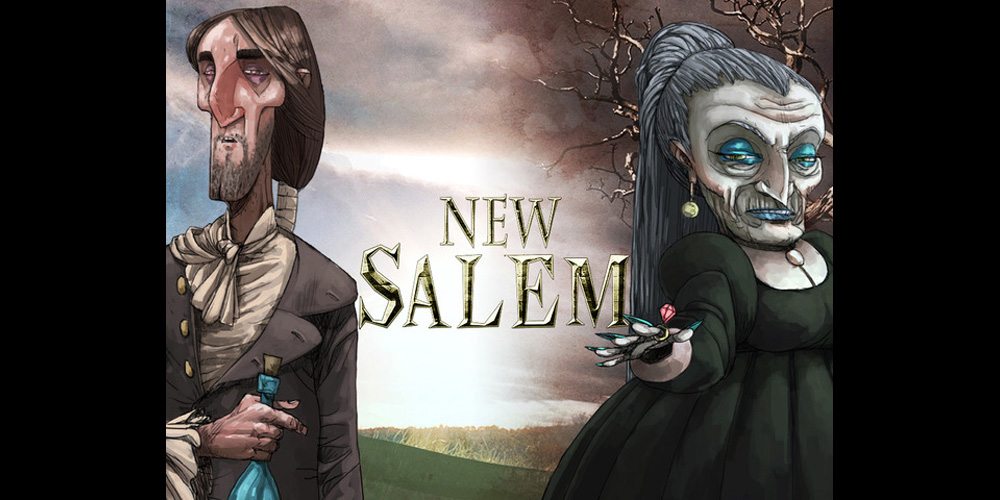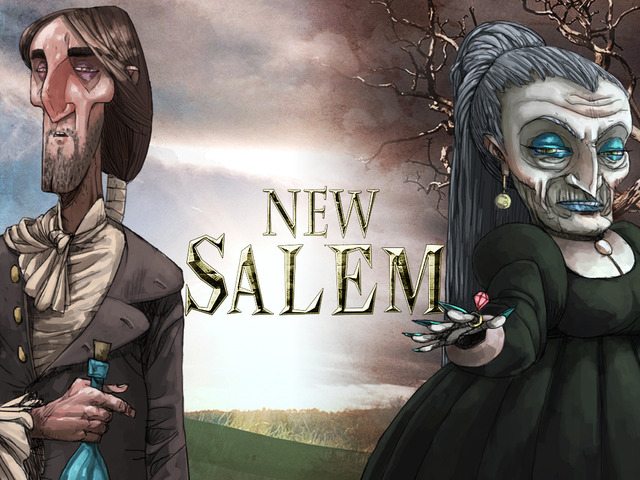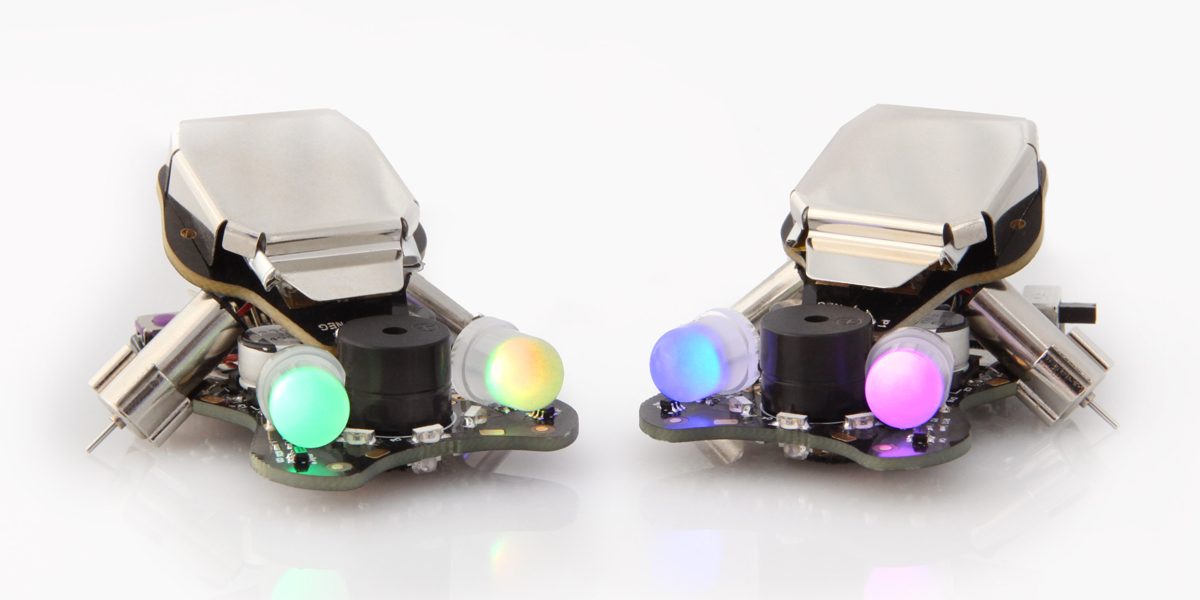Salem is, as everyone knows, overrun with witches. So you, fine upstanding citizens that you are, have decided the best solution is to leave and found a new town named, naturally, New Salem. Everyone is trying to build their town free from the despair caused by witches. The bad news? Some witches might be hiding in your midst. New Salem is a game from Overworld Games (publishers of Good Cop Bad Cop) currently seeking funding on Kickstarter.
At a glance: New Salem is for 3 to 8 players, ages 14 and up, and takes from 30-60 minutes to play. The basic pledge level on Kickstarter for a copy of the game is $26. You might be able to play with players a little younger than 14, but because of the thematic content and hidden roles, I would suggest not too much younger than that.
New to Kickstarter? Read our crowdfunding primer.

Components:
This is the components list as shown on the Kickstarter page. My prototype set is cards only without finished art, but some closer-to-final art by Andrea Olgati has been revealed, and it looks pretty great. I especially like the way that the sets of cards that go together form a tableau. Currently the resources (Hope and Despair) are cards, but will be changed to wooden cubes if the stretch goal is hit, which seems fairly likely.
- 6 Event Cards
- 144 Building Cards
- 25 Hope Cards (A stretch goal will upgrade these cards to cubes)
- 25 Despair Cards (A stretch goal will upgrade these cards to cubes)
- 5 Round Cards (A stretch goal will upgrade these cards to cardboard chits)
Overworld Games is also working together with Game Trayz to offer a $10 add-on tray for New Salem. I’m particularly excited about this, because at Gen Con I was able to introduce Brian Henk from Overworld Games to Noah Adelman of Game Trayz. Henk was as impressed as I was about the trays, and loved the idea of incorporating it into a Kickstarter campaign right from the start. I’d love to see more of this happening!

How to Play:
Overworld Games has a how-to-play video on YouTube if you prefer video tutorials.
The goal of New Salem is to have the most points, which you get by completing sets of buildings and playing buildings that match your character. However, Puritan players may only win if the total Despair in the town stays below a certain threshold; otherwise, a witch player will win instead.
First, character cards are distributed—there will be a certain number of Puritan and Witch cards included, based on the number of players. Since you always use one more card than there are players, you’ll never know exactly how many witches there are. With fewer players, there may not be a witch at all … but you may not know for sure until the end. (Basically in games with fewer players there may be one witch; with more players, there will be at least one but possibly two.)
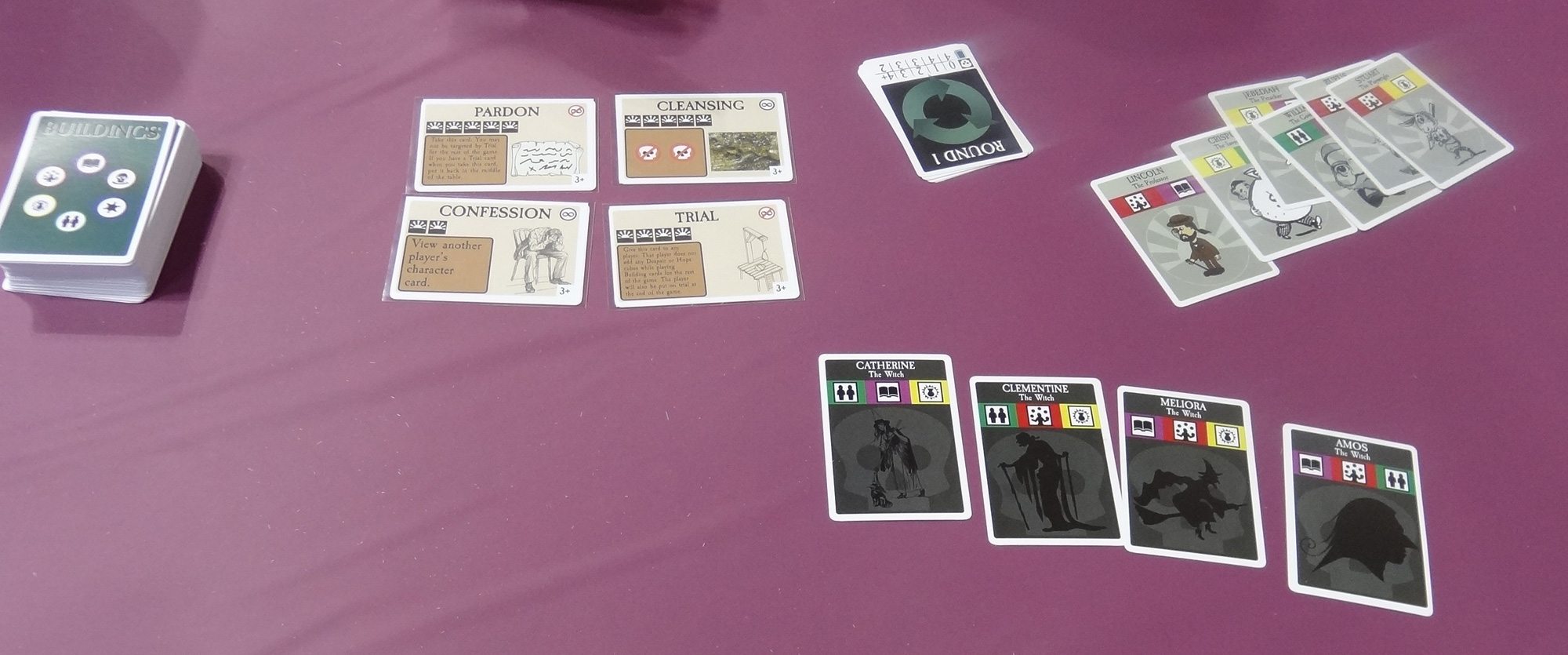
You’ll sort out building and event cards according to the number of players, removing those that are for more players. Event cards are placed in the center of the table where everyone can see them.
Then you shuffle the buildings. Each of the five rounds, you deal out a certain number of buildings to each player (depending on the round). Then there’s a round of drafting—you choose one card from your hand, put it face-down in front of you, and pass the rest of your cards.
When you get passed two cards, you may either choose one to play and discard the other, or discard both cards and take your chances with a single card from the deck, which you must play. After the drafting phase, everyone reveals their buildings. Some buildings have Hope or Despair icons, in which case you take those resources from the supply and place them on those cards. There are also some buildings that allow you to remove one Despair from the town.
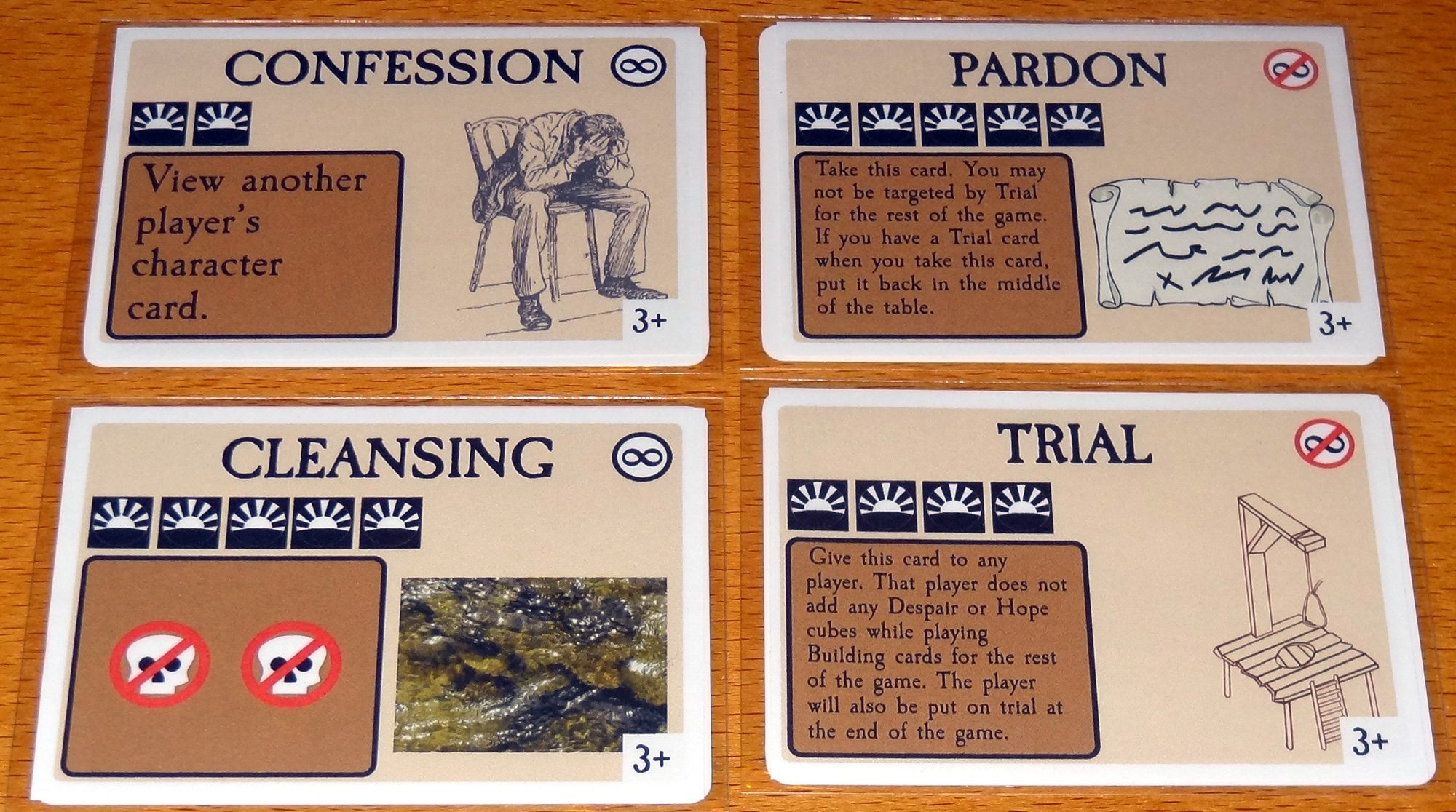
Now you get to initiate events. Any player may give Hope to any other player, and any player may spend Hope to trigger an event. Some events require a lot of Hope to initiate, but you don’t just pool the Hope; you have to give it to a single player, who may then decide how to spend it. Confession lets you peek at another player’s character card to see if they’re a witch or a Puritan. Trial prevents a player’s cards from generating Hope or Despair, and also will put them on trial at the end of the game. Cleansing lets you remove two Despair from the town. Pardon protects you from Trial for the rest of the game.
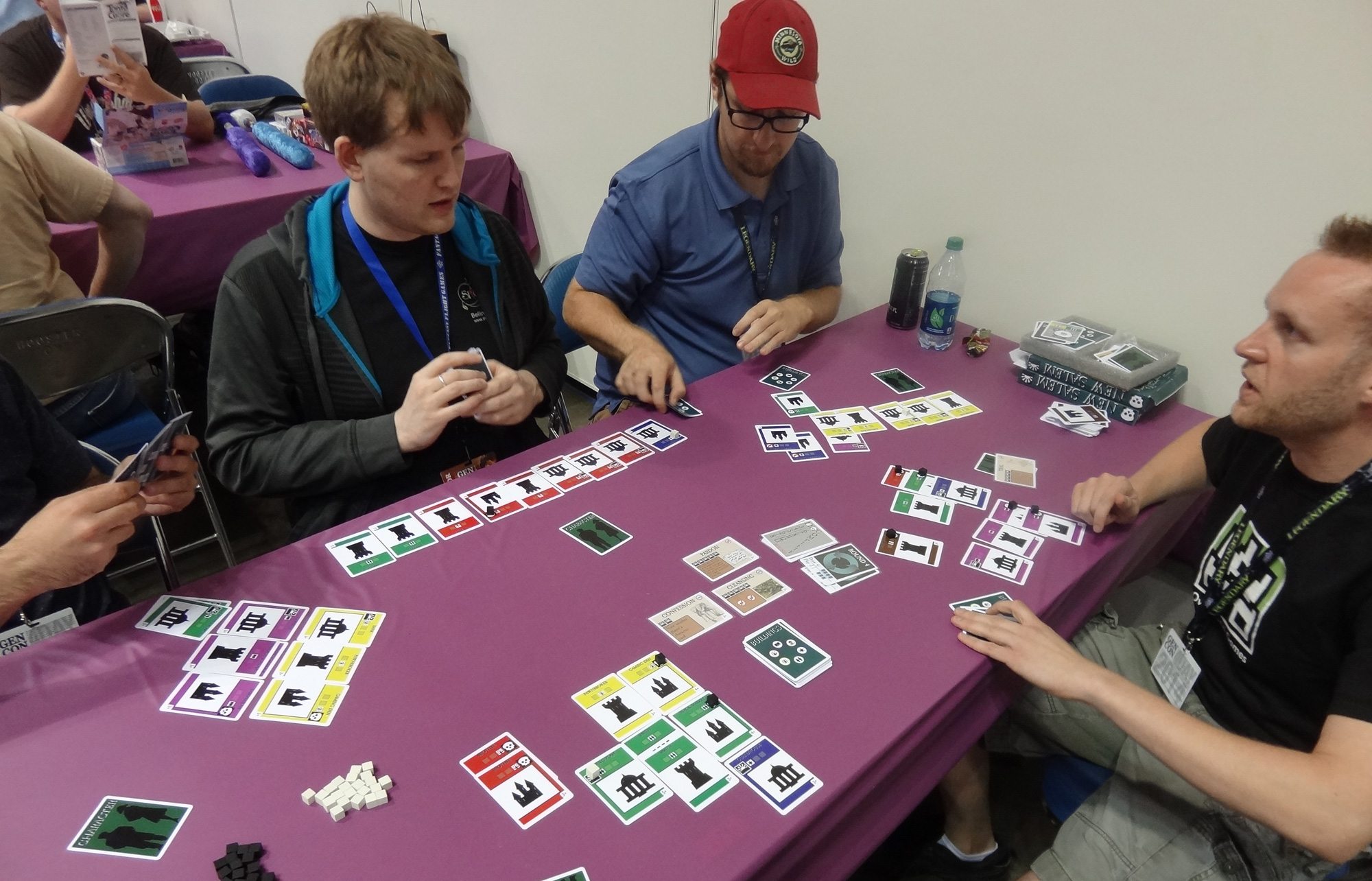
After five rounds of drafting and events, you resolve any Trials. Everyone reveals their character cards. For every witch that was put on trial, you remove one Despair from the town. For every witch that escaped trial, you add a Despair to the town. (Puritans on trial have no effect, other than using up Trial cards that should have been for witches.)
Once the Trials are resolved, you look at the chart to find out the Despair threshold for the number of players you have. If there is enough Despair, then the witch with the most Victory Points wins. Otherwise, the Puritan with the most Victory Points wins. And if there is more Despair than the threshold but there are no witches, then everyone loses, you selfish, uncooperative Puritans.
You get 1 point for each building that matches a type shown on your character card, and 2 points for each complete matching set of 3 buildings.
The Verdict
New Salem is an interesting mix of mechanics: the drafting and set collection is similar to something like Sushi Go, where you’re trying to maximize your score while also watching what you pass to the next player. There are plenty of hidden role games, too, with or without traitor players working against the rest. But New Salem combines those two in a way that adds some new tricks.
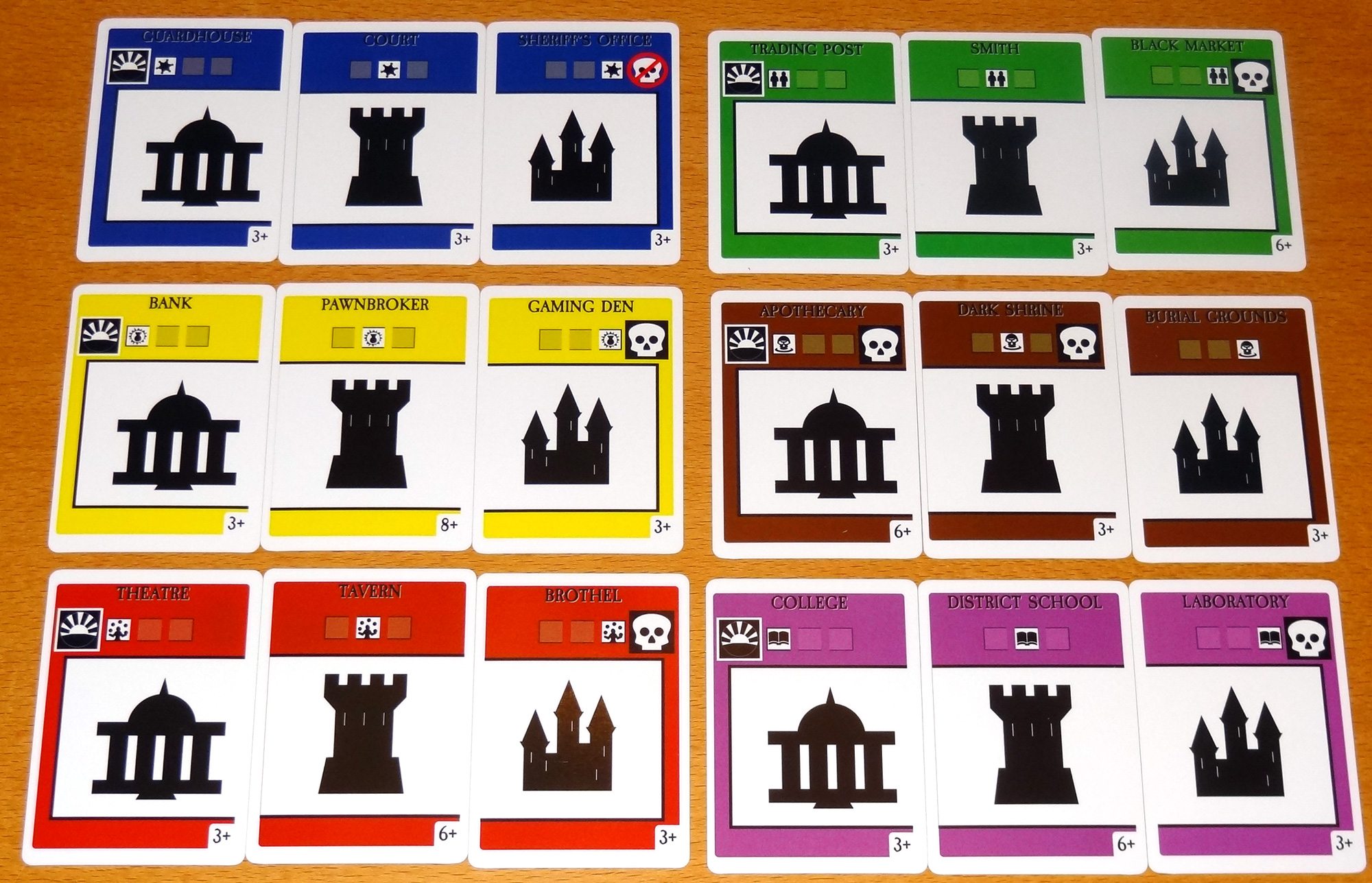
One of the things that makes it harder to identify a potential traitor is that each of the types of buildings has both a Hope icon and a Despair icon. The Law buildings (blue in the prototype photo above) are the only ones that allow you to remove a Despair, and the Gloom buildings (brown above) have two Despair in a set. But neither of those types of buildings will give bonus points to any of the characters.
If somebody plays a building that has Despair on it, they might be a witch—or they might just have that color on their character card. Or maybe they’re just trying to get points for that set, or they got passed that card and it was the better of two options. At any rate, it can be hard to distinguish a witch from a selfish Puritan.
Using the Hope as a currency to trigger events also leads to more opportunities for deduction and trickery. Confession is cheap—costing only two Hope to look at somebody’s card—but it also uses up Hope that could go toward removing Despair or putting a witch on Trial. If you’re a witch, you could try to convince people to use Confession on each other, or even you—knowing that even if one player sees your card, perhaps you could convince the other players that you’re being framed by a witch.
And since the bigger events generally require pooling resources, the player who gets the Hope could use it to remove Despair … or grab the Pardon for himself instead. The fact that there’s a lot of mutual distrust encourages players to work against each other, which then gives the witch players a chance to sneak in a victory.
The one thing I wasn’t sure about is the Trial card’s effects: when you’re on Trial, your buildings no longer generate Hope or Despair. It’s a way to prevent a suspected witch from continuing to put more Despair in the town, but it also means that player no longer has any way to buy a Pardon unless given Hope by other players (who are unlikely to do so). With more players, there’s the possibility of two witches, in which case the other witch could try to collect Hope and give it to the other for a Pardon, but even the witches are playing selfishly. There isn’t any player elimination, so getting put on trial doesn’t knock you out of the game, but it does feel like it takes away a lot of your power, whether that’s to add Despair as a witch or contribute Hope as a Puritan.
I really liked Good Cop Bad Cop (also designed by Brian Henk and Clayton Skancke), which had a nice spin on hidden role games, and I wondered if New Salem would be pretty similar. But aside from the fact that there are hidden roles, the game itself is quite different and has its own rhythm to it. It’s a little more calculating, with the drafting and trying to remember what you passed to another player and what they ended up using. And, of course, there are no guns waving around.
I do like the look of the artwork that I’ve seen so far, and even though it’s a relatively small game, it’ll be cool to have a game that had a Game Trayz designed for it right from the start. There aren’t a lot of fancy components, but I think it’s a solid game.
If you’re curious about New Salem, you can also back the project at $3 to get access to the print and play (which uses graphics similar to what you see in the prototype photos above), and then up your pledge if you decide you like it. Oh, and if you missed Good Cop Bad Cop, you can get a bundle deal through this campaign as well.
For more about New Salem, visit the Kickstarter page!
Disclosure: GeekDad received a prototype copy for review.
